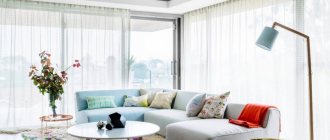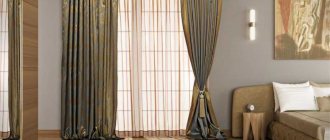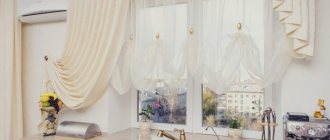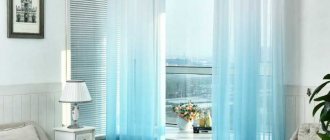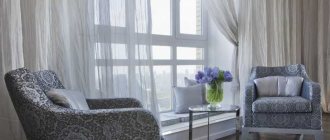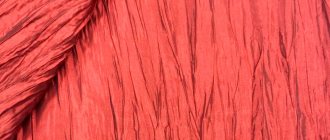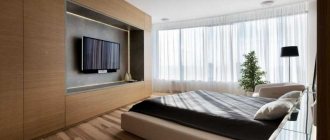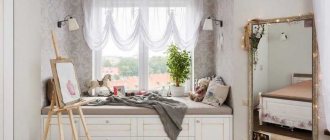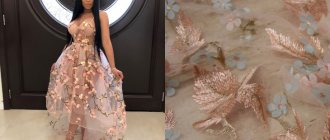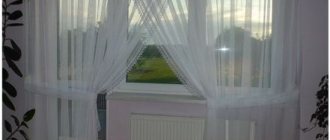What is tulle
Tulle (curtain) is a translucent type of curtain woven from threads of one or more compositions. In the latter case, the tulle mesh on the window looks decorative. However, the corresponding effect also contributes to:
- Floral patterns embroidered directly onto the tulle;
- Inserts in the form of braid, stripes and pendants;
- Vertical or arched folds.
Compared to curtains, tulle is light in weight and therefore places little stress on the cornice. Therefore, the use of thematic curtains without curtains in certain situations comes in very handy - if the cornice is single or if the space requires lighting. Moreover, the tulle can be double - for convenient straightening in different directions to facilitate access to the glazing.
Manufacturers and prices
Currently, on the modern market there is a wide selection of tulle mesh with embroidery. Among the entire assortment you can see Turkish, French curtains, as well as Russian ones.
The most popular manufacturers include:
- Altax – price 1600 rubles per linear meter;
tulle mesh with Altax embroidery - ARIA – price 1200 rubles per linear meter.
tulle mesh with ARIA embroidery - Gallery – price 1080 rubles per linear meter.
tulle mesh with Gallery embroidery - Lila – price 1170 rubles per m.p.
- Milano – price 1300 rubles per linear meter.
- Shanxing – price 980 rubles per linear meter.
The anti-mosquito miracle curtain will save you from mosquitoes.
How to choose beautiful nightgowns in large sizes?
Reviews and prices for bamboo pillows: .
Purpose of tulle
Tulle is a lightweight fabric that is often less expensive than drapes. But is it worth comparing the cost of two types of curtains if they complement each other? Moreover, tulle is in a certain sense more functional than curtains:
- Masking the room (drapes completely cover the space from prying eyes, and tulle partially covers it);
- Diffusion of light (curtains, even when closed, let in daylight, and curtains only darken the space, and therefore partially create a play of color in the interior);
- Ventilation of the room (air passes through the curtains freely);
- Catching insects (sometimes arthropods flying inside get entangled in the veil).
And of course, mesh tulle in the interior makes the curtains more presentable. To verify this, just move two heavy curtains in different directions and leave the curtain in place. However, this technique is not suitable for all interior styles and spaces.
Fashion trends
Recent trends dictate the use of embroidery, lace or guipure on tulle. It was popular before, but today it has gained considerable momentum thanks to design shows. The decorating trend is Victorian era fashion. It applies not only to things, but also to accessories, as well as window textiles. To be on trend, you should choose the right embroidery motif. The following are in demand:
- damask pattern. He made a splash at the annual exhibition in Milan. The pattern itself consists of large symmetrical figures with swirls and plants forming the design. The latest fashion is a combination of damask motifs and fabric of simple texture - linen or cotton;
You might be interested in this Interesting patterns for embroidering pictures using beads with full stitching
Products with lurex
- "hand made style". Small bouquets or large flowers in handmade style have always been in demand, but they appeared relatively recently as embroidery on tulle, instantly becoming popular. A hand-drawn drawing can blend smoothly with the main color scheme, or it can stand out noticeably with the brightness and contrast of the patterns;
Ethnic pattern
- ethnic motives. Perhaps this is the only style that, during its existence, has absorbed such a huge variety of shapes, colors and design options. Its peculiarity lies in the fact that the ethnic pattern combines elements and ornaments of almost all national costumes of the world. Every person will be able to find in it something familiar and close to themselves.
Damask pattern
Current rooms
Some rooms have an atmosphere inside that quickly wears out the fabric. Such places include a bathroom, kitchen, balcony, workshop. Therefore, their glazing increasingly features blinds and roller shutters, which do not require decorative finishing in the form of tulle. Rooms for relaxation and sedentary work, on the contrary, welcome tulle. These rooms include:
- Bedroom;
- Living room;
- Study;
- Children's room.
On the other hand, tulle mesh for the kitchen can be a good window frame if there are several curtains and they have decorative stripes or embroidery. Also, do not neglect the location of the tulle: you can hang the curtains in the classic way or in the European way, so that they have arc folds. Another presentable technique for the kitchen is fitted tulle.
The use of decorative elements in interiors of different styles
Curtains and tulle with embroidery appeared in the eighteenth century. At that time it was often used in the following styles:
- classicism, renaissance or baroque. It’s hard to imagine classic solutions in these motifs without airy and lush products, the basis of which were decorations in the form of plants and complex patterned ornaments, as if floating in the air;
Neoclassical style
- Romanesque interior, eclecticism and empire style. These styles used large canvases with silver or gold embroidery. They are also characterized by the presence of a large coupon along the bottom of the air curtain;
- neoclassical style, neomodern and modern. Their feature was subtle and graceful transitions. This concerned not only the products themselves, but also the patterns on the surface. The tulle ornament in neostyles is soft and has smooth and measured transitions, and does not use broken or sharp lines;
- country and ethno. These trends also cannot do without embroidered curtains, using vegetation and a fantasy orientation for motifs.
Romanesque tulle
Important! Modern types are not very similar to what was used at the very beginning of tulle as a decorative element. Despite this, harmony with modern interiors can be achieved by using complex geometric patterns.
You might be interested in this: How to properly embroider pictures and clothes with rhinestones
French tulle
The thematic network is crocheted and therefore stands out with columns in the form of links made of air loops. To understand the corresponding description, just look at a fishing net with small or large mesh. However, unlike seine, French tulle can be colored and sometimes even includes embroidery.
The straightness of French curtains makes them suitable for framing any windows. But the curtains will have to be selected - it is desirable that they be simple. At the same time, French tulle is suitable even for roller blinds.
Other types of tulle
In addition to French and Turkish tulles, the curtain market offers many other themed products. Most of them are chosen according to the culture of a particular country:
- Greek tulle - a golden veil with meanders or spirals;
- Roman tulle is a veil of noble warm colors with curly embroidery or one attractive olive wreath;
- English tulle - white folding curtain with vintage patterns and bows;
- Austrian tulle is an analogue of English curtains, but with many folds and awnings;
- German tulle - a single-color sliding curtain with simple patterns;
- Japanese tulle - panels trimmed with curtains with vertical flowers or hieroglyphs in the middle.
As a result, the finished interior will always tell you what kind of tulle you need to purchase. At the same time, it is recommended to choose curtains together with drapes, imagining their future configuration in advance.
Difficulties in choosing curtains
There are several factors to consider when choosing curtains. First of all, pay attention to the interior of your room. Turkish tulle should fit harmoniously into the surrounding environment, emphasize it favorably, and place the necessary accents.
So, for a living room, Turkish tulle in calm shades with embroidery with gold or silver thread, complemented by moderate shine, is suitable. Give preference to thicker fabrics that create symmetrical drape.
For the bedroom, it is best to choose light, airy curtains with floral motifs or guipure inserts. They will help emphasize the comfort of the room and create an environment favorable for relaxation. Curtains made of light, translucent materials are perfect for the bedroom.
When decorating a child's room, pay attention to tulle in brighter colors. For example, pink, blue, purple and others. When creating a nursery, the color scheme is limited only by your imagination. Curtains decorated with drawings of animals, animated characters and favorite heroes are perfect.
If you choose Turkish tulle for the kitchen, pay special attention to the material from which the curtains will be made. It is worth remembering that the selected material will often get dirty, so give preference to unpretentious fabrics that are easy to care for.
Don't choose curtains that are too long. For the kitchen, the optimal solution would be options where the length of the curtains barely reaches the window sill.
Pay special attention to decorating Turkish tulle. Various clothespins, clips and grips can be used as decoration. They will help create the correct drapery of the curtains, fix them in the right position and create the right lighting.
Turkish curtains can also be decorated with various tassels and fringes. If desired, lambrequins can be made.

